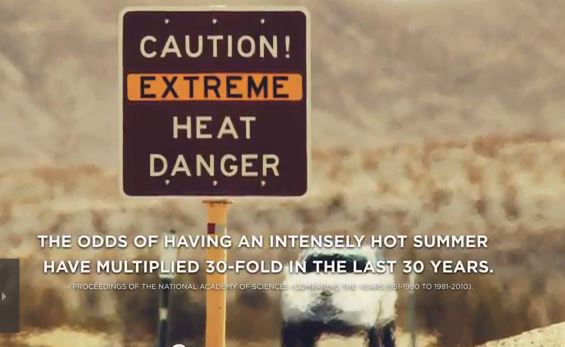What does climate change look like?
Everyone has a different answer.
To a Texas rancher, it’s the drought that’s starving his cattle. To a worried mother in New York City, it’s the stultifying heat wave that’s setting off her child’s asthma. To an Iowa farmer, it’s hundreds of acres of unplanted fields, either withered by drought or flooded by heavy rains. To a New Jersey homeowner, it’s the storm that has destroyed her seaside community.
Watch this NRDC video…
Every year since 2010, NRDC has encapsulated the year’s climate change impacts into a two-minute video. Every year, this task becomes more challenging, as more communities in America and worldwide feel the devastating impacts of climate change. This past year was no exception: two-thirds of the country sweltered in a vast July heat wave; wildfires burned 1.2 million acres of U.S. forest in June alone.
But this year, 2014, could at last mark a major turning point.
This is the year that America, as a nation, will take steps to reduce the biggest source of climate pollution in the country: carbon pollution from existing power plants. This could be our best chance yet to slow down the runaway train of climate change. We can’t afford to squander it.
In June, the EPA will release its first-ever proposal to limit pollution from existing power plants, which are responsible for 40 percent of U.S. carbon emissions. The proposal will likely be based on a blueprint created by NRDC, which demonstrates that we can cost-effectively reduce this pollution 21 to 31 percent by 2020, compared to 2012 levels. The economic benefits of the plan, from lives saved, illnesses reduced, and climate damage avoided, range from $21 billion to $53 billion by 2020—that’s over and above cost.
The proposal will likely build on solutions that are already working on the ground. The number of people impacted by climate change may be growing, but so is the number of people who are benefiting from climate change solutions: whether it’s a factory worker who sustains her family during the recession because she works on building wind turbines; or a homeowner who enjoys a more comfortable home and lower energy bills by installing better insulation. In fact, a full 25 percent of the U.S. population lives in states that are already successfully cutting carbon pollution from power plants.
We know that clean energy and efficiency solutions work.
But we need to expand these solutions to cut more pollution, and we need to do it now.
Reducing carbon pollution from power plants is absolutely vital to protecting ourselves and future generations from the most devastating impacts of climate change. The Obama administration is serious about seizing this moment. We can’t afford to lose momentum. The limits EPA proposes need to be strong; and President Obama, Congressional and state leaders need to know that their constituents support this critical effort to limit dangerous carbon pollution.
Take action!
Speak out and demand strong limits on carbon pollution from power plants.
Bonus!
Listen to the last Green Divas Radio Show with science communicator Greg Laden talking about the impact of climate change on animals.
Written by Peter Lehner for NRDC. Published with permission.
